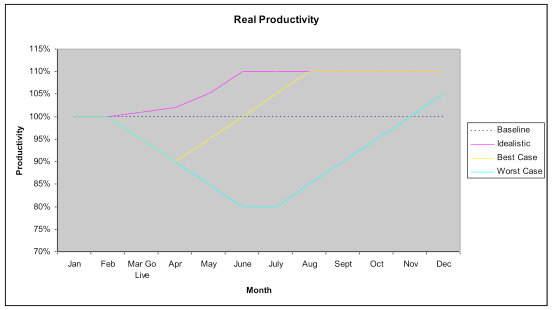Installing a Tier 1 Labor Management System and implementing Engineering Labor Standards provides a reliable Return-On-Investment for any operation. It is not unusual to fully pay back the entire project cost within one year.
The impact on the P&L is substantial. The impact on the people can be earth shattering.
 A Three-legged Stool
A Three-legged Stool
A Labor Management System implementation project is truly a three-legged stool. Success requires that all three legs completely support the project. The three legs are: the technology, the engineering, and the people. If any leg falters the stool tips and project success is at risk. Unfortunately, most companies tend to focus primarily on the technology and the engineering when developing the project plan. Generally, the people aspect is left out entirely or severely under resourced. Consequently, the stool tips at project go-live and a great deal of time and treasure is spent righting the stool. Often the creditability of the management team and the LMS is damaged.
The thorough development, execution, and resourcing of a Change Management plan is the only way to ensure the structural integrity of the third leg, the people.
The Associate’s Perspective
My supervisor has told me for years that I am a good employee. Every week I meet or exceed my supervisor’s productivity requirements on the jobs that are measured. I enjoy the pace of my job as it allows me to go to break early, return late, and I usually find time between measured jobs to keep up with what is going on in the lives of my coworkers. Although I have to keep a steady pace when on a measured job, there is sufficient opportunity between jobs to relax and socialize. My workplace provides me with a balanced environment whereby I meet my employer’s production expectations at a fair wage with little effort.
If asked to produce more, I would expect my employer to pay me a higher wage.
Common Symptoms
LMS implementation projects with under planned, under executed, and under resourced Change Management plans consistently demonstrate the following symptoms after go-live:
- A large number of associates are unsuccessful in their attempt to achieve acceptable performance.
- The workforce begins to feel that management’s expectations are unachievable and unfair – so they give up and productivity dips.
- As management places additional pressure on associates to achieve acceptable performance, the workforce rebels and productivity takes a deep dip.
- Supervisors begin to believe that the LMS is generating unachievable expectations and they align themselves with the associates.
- The Management Team aligns itself with the supervisors and associates and demands that the Vendors fix the LMS and ELS and no longer holds the associates to any set of expectations – productivity dips further.
Many inexperienced implementers of LMS/ELS expect that after go-live, productivity will immediately zoom upward. Unfortunately productivity takes a dip. How deep and for how long is totally dependent upon the quality and execution of the Change Management Plan.
The graph below illustrates real productivity in an LMS implementation:
Nearly all LMS implementation projects result in a dip in productivity after go-live. The depth of dip is directly related to the effort placed on the Change Management Plan.
Thorough Change Management
A thorough change management plan is based on the following 5 principles and 6 strategies:
Principles
- Over-Communicate
- Honesty is the Best Policy
- Educate
- Involve
- Adapt
Strategies
- Develop/execute the Communication Plan (starts today, ends one year from go-live)
- Adapt/execute the Compensation Plan
- Develop/adapt/execute the Discipline Plan
- Develop/execute the Training Plan
- Develop/execute the Associate/Supervisor Involvement Plan
- Develop/execute the Renewal Plan
A thorough change management plan is not expensive; however, it requires the investment of time and attention.
The Communication Plan
Three Questions from the Associates
- The most important and difficult question for one to answer HONESTLY will be: Why do we need to implement a Labor Management System with Engineered Labor Standards?
- If one answers honestly: Because we believe an LMS will result in higher productivity.
- The next question is: How could we be more productive? Have we not been meeting your productivity expectations all along?
- If one answers honestly: An LMS will measure productivity through the entire day, not just the jobs that are currently measured.
- The next question is: If the company is going to ask me to be more productive, is the company going to pay me more?
- If one answers honestly what would one say?
Associate Venues
- The initial facility communication should occur after all strategies have been planned out – as one must be able to answer the three questions above. The Compensation plan obviously is important.
- Small group meetings should occur throughout the project and, thereafter, for a year.
- Story boards should be erected in key gathering areas such as the break rooms and cafeteria. The story boards should maintain the current project timeline, milestones, interesting positive stories, etc.
- Supervisors should purposefully communicate one-on-one with associates to answer questions and elicit feedback.
- A committee of associate opinion leaders should be formed. This group should be provided a great deal of visibility into the project and should be a key source of employee feedback.
Supervisor Venues
- Prior to the initial communication with the associates, supervisors should be brought up to speed. A presentation by the Project Team would be very beneficial.
- Periodically the Project Team should update the supervisors.
Feedback
- All feedback from supervisors and associates should be funneled to whom ever is responsible for managing the Communication Plan.
- The Communication Plan should adapt as necessary based on the feedback.
- The goal is for Communication = Feedback. In other words, only through the feedback can one determine the success of the Communication Plan.
The Compensation Plan
Associate Expectations
As productivity improves under the LMS environment, employees will have less idle time and WILL work more – it is the reason one makes this investment. If not immediately, eventually associates will arrive at Question 3 –”If the company is going to ask me to be more productive, is the company going to pay me more?”
If the answer is “no,” then no matter how one tries to sell LMS – it is a negative and the “dip” will be deeper and longer — as resistance and disappointment will grow.
The most effective method for minimizing the depth and duration of the productivity dip is provide some sort of gain sharing incentive to compensate the associates for some of the incremental productivity. The reason is pretty obvious. The associates have been told for years (in advance of the LMS) that they were doing what is expected of them and, therefore, earning their wage. If asked to do more work, they expect that the company will be fair with them by increasing their wages. Providing short and/or long term gain sharing incentives meets this expectation and reduces resistance to accepting the new paradigm
Watchout – No gain sharing plan will be effective in an environment where overtime is common place. To be effective, incentive pay must be more lucrative than overtime. One should minimize overtime for several months before implementing incentive pay.
Watchout – Incentive pay should never be tied to productivity alone. Quality, service, and safety must also be represented in an effective incentive pay system otherwise they will suffer.
The Discipline Plan
Generally, management provides a minimum performance expectation. In the world of LMS and ELS, the minimum cannot be any greater than the statistical accuracy of the ELS. For example, most selection and forklift ELS have a confidence of +/- 5% of normal with 95% accuracy. Therefore, the maximum discipline level can be no greater than 95% of the standard.
Likewise, the period of evaluating the performance to standard is tied to sample size of the observations utilized during the ELS development. As an example, an associate’s minimum performance to standard (discipline level) in selection is 95% for 40 hours of work and 85% for 8 hours of work.
Associates will lose proficiency when they perform work “part time.” The Discipline Plan should outline the expectations of those who perform work “part time.”
Productivity (performance to standard) represents a symptom of either a training issue or a behavioral problem. One should not discipline based on performance to standard. Performing below the “discipline level” is an indicator for management that the associate has a training issue or behavioral problem.
The first “discipline” step should be one or more observations by the supervisor of the associate performing their work. The supervisor should council the associate on their performance of the work by the documented preferred methods. The objective should be to demonstrate to the associate that when they perform according to the preferred method they are able to perform above the “discipline level.” This step is essentially retraining for the associate. All such observations should be performed on a standardized observation sheet extracted from the preferred method.
The discipline plan should outline the discipline steps and should focus on the associate’s ability to learn/execute the preferred method. Only through several steps of retraining should the associate be terminated.
Generally behavior problems related to performance to standard is associated with leaving for breaks/lunches early, arriving from them late, or talking when they should be working.
Watchout – Changes in the discipline policy must be properly staffed with Human Resources and communicated effectively to both management and associates in advance of the LMS go-live.
Watchout – In a work environment under a Union Contract, discipline policy must correspond to that of the Union Contract.
The Training Plan
The Training Plan needs to consist of three components: associate training, supervisory training, and subject matter expert (SME) training.
All training should consist of the following steps: demonstration, hands on, evaluation, remedial training, certification.
Associate Training
Associates must be trained to perform their work according to the preferred methods. Those company trainers responsible for training new employees must train according to the preferred methods.
All Associates should be certified in their position prior to the onsite development of ELS.
Associates should be instructed on how the LMS works and how the ELS were developed.
Supervisory Training
Supervisors must be trained on the preferred methods employed in their area of responsibility.
Supervisors should be instructed on how the LMS works and how the ELS were developed.
Supervisors must have special training on how best to support associates working in an LMS/ELS environment.
Subject Matter Expert (SME) Training
The SME must be trained on all preferred methods.
The SME should be instructed in detail on how the LMS works and how the ELS were developed.
The SME must have special training on how best to support associates working in an LMS/ELS environment.
The SME must be certified to maintain the LMS and ELS.
The Associate/Supervisor Involvement Plan
The LMS/ELS must be credible Day One.
Involving Associate Opinion Leaders and Supervisors is extraordinarily effective at building credibility.
LMS/ELS projects require a great number of labor hours. One can get a great deal of work done while simultaneously involving both associates and supervisors in the implementation. Add instruction along the way to pull pieces together and credible subject matter experts are developed.
It is preferred to incorporate into the LMS/ELS team a few associate opinion leaders utilizing them in every practical phase of the implementation.
The goal is to demonstrate that the LMS is not a Black Box and that the ELS were developed with fairness and accuracy.
One can execute the best Communication Plan, but without involved Associates and Supervisors, the LMS is just a Black Box.
The Renewal Plan
Renewal is the process by which one learns from their mistakes and institutionalizes his/her successes.
The Renewal Plan must perform the following:
- Evaluate the effectiveness of the LMS, the accuracy of the ELS, and the operation’s utilization of both.
- Identify that which meets or exceeds expectations and that which does not.
- Develop/execute a plan to bring the failing areas into compliance.
A Renewal Plan is a project unto itself. It may include all the previous stated plans (Communication, compensation, discipline, etc.)
No LMS/ELS project is absolutely perfect. The Renewal Plan offers a 2nd chance to achieving missed opportunities.
Conclusion
A thorough change management plan based on the following 5 principles and 6 strategies will minimize the depth and length of productivity loss incurred when an LMS/ELS is implemented.
Principles
- Over-Communicate
- Honesty is the Best Policy
- Educate
- Involve
- Adapt
Strategies
- Develop/execute the Communication Plan (starts today, ends one year from go-live)
- Adapt/execute the Compensation Plan
- Develop/adapt/execute the Discipline Plan
- Develop/execute the Training Plan
- Develop/execute the Associate/Supervisor Involvement Plan
- Develop/execute the Renewal Plan
Change management is necessary for strengthening the third leg (People) of the three legged stool that is an LMS/ELS implementation project. Without devoting attention and resources to the People, the stool will tip and the project can fail.
About the Author
Larry Parker graduated from Cornell University in 1978 with Bachelors of Science Engineering and was commissioned a 2nd Lieutenant in the US Army. After 4 years of service, Larry began his career in the Supply Chain as a Fleet Supervisor for Pepsi Bottling. After positions as Warehouse Manager, Transportation Manager, Plant Engineer, and Fleet Manager with Pepsi Bottling, Coca Cola, and Perrier, he took a Project Manager position with Color Tile. Within six months, he was promoted to Director of Logistics where he had P&L/operational responsibility for the four distribution centers, importation of all overseas materials, and transportation of goods to more than 1,000+ retail stores in the US, Canada, and Mexico. Larry implemented the Dallas System (now Infor) WMS/LMS in his four distribution centers and ELS in two of them. Larry, then, took a Sr. Engineer position with Dallas System that led to a Director of Consulting Services role. After several years, he and another DS associate struck out on their own to establish Resource Management Services, a consulting firm specializing in implementing LMS/ELS. Fifteen years later, Larry Parker continues to provide Consulting and Engineering Services to the Supply Chain.
Change Management Plans
Larry Parker utilizes his extensive experience in warehouse operations and ELS development to assist his clients in developing Change Management Plans. Why would you “reinvent the wheel” when you could take advantage of Larry’s experience?


Leave A Comment